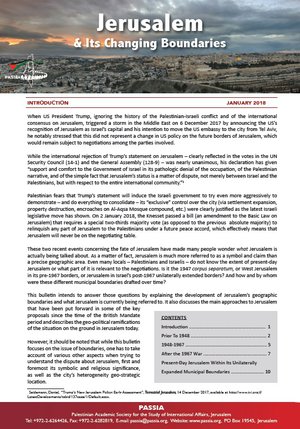Jerusalem & Its Changing Boundaries
Overview
When US President Trump, ignoring the history of the Palestinian-Israeli conflict and of the international consensus on Jerusalem, triggered a storm in the Middle East on 6 December 2017 by announcing the US’s recognition of Jerusalem as Israel’s capital and his intention to move the US embassy to the city from Tel Aviv, he notably stressed that this did not represent a change in US policy on the future borders of Jerusalem, which would remain subject to negotiations among the parties involved.
While the international rejection of Trump’s statement on Jerusalem – clearly reflected in the votes in the UN Security Council (14-1) and the General Assembly (128-9) – was nearly unanimous, his declaration has given “support and comfort to the Government of Israel in its pathologic denial of the occupation, of the Palestinian narrative, and of the simple fact that Jerusalem’s status is a matter of dispute, not merely between Israel and the Palestinians, but with respect to the entire international community.”
Palestinian fears that Trump’s statement will induce the Israeli government to try even more aggressively to demonstrate – and do everything to consolidate – its “exclusive” control over the city (via settlement expansion, property destruction, encroaches on Al-Aqsa Mosque compound, etc.) were clearly justified as the latest Israeli legislative move has shown. On 2 January 2018, the Knesset passed a bill (an amendment to the Basic Law on Jerusalem) that requires a special two-thirds majority vote (as opposed to the previous absolute majority) to relinquish any part of Jerusalem to the Palestinians under a future peace accord, which effectively means that Jerusalem will never be on the negotiating table.
These two recent events concerning the fate of Jerusalem have made many people wonder what Jerusalem is actually being talked about. As a matter of fact, Jerusalem is much more referred to as a symbol and claim than a precise geographic area. Even many locals – Palestinians and Israelis – do not know the extent of present-day Jerusalem or what part of it is relevant to the negotiations. Is it the 1947 corpus separatum, or West Jerusalem in its pre-1967 borders, or Jerusalem in Israel’s post-1967 unilaterally extended borders? And how and by whom were these different municipal boundaries drafted over time?
This bulletin intends to answer those questions by explaining the development of Jerusalem’s geographic boundaries and what Jerusalem is currently being referred to. It also discusses the main approaches to Jerusalem that have been put forward in some of the key proposals since the time of the British Mandate period and describes the geo-political ramifications of the situation on the ground in Jerusalem today.
However, it should be noted that while this bulletin focuses on the issue of boundaries, one has to take account of various other aspects when trying to understand the dispute about Jerusalem, first and foremost its symbolic and religious significance, as well as the city’s heterogeneity geo-strategic location.
Contents
Introduction .......................................................... 1
Prior To 1948 ......................................................... 2
1948-1967 ............................................................. 5
After the 1967 War ................................................ 7
Present-Day Jerusalem Within Its Unilaterally Expanded Municipal Boundaries ......................... 10

